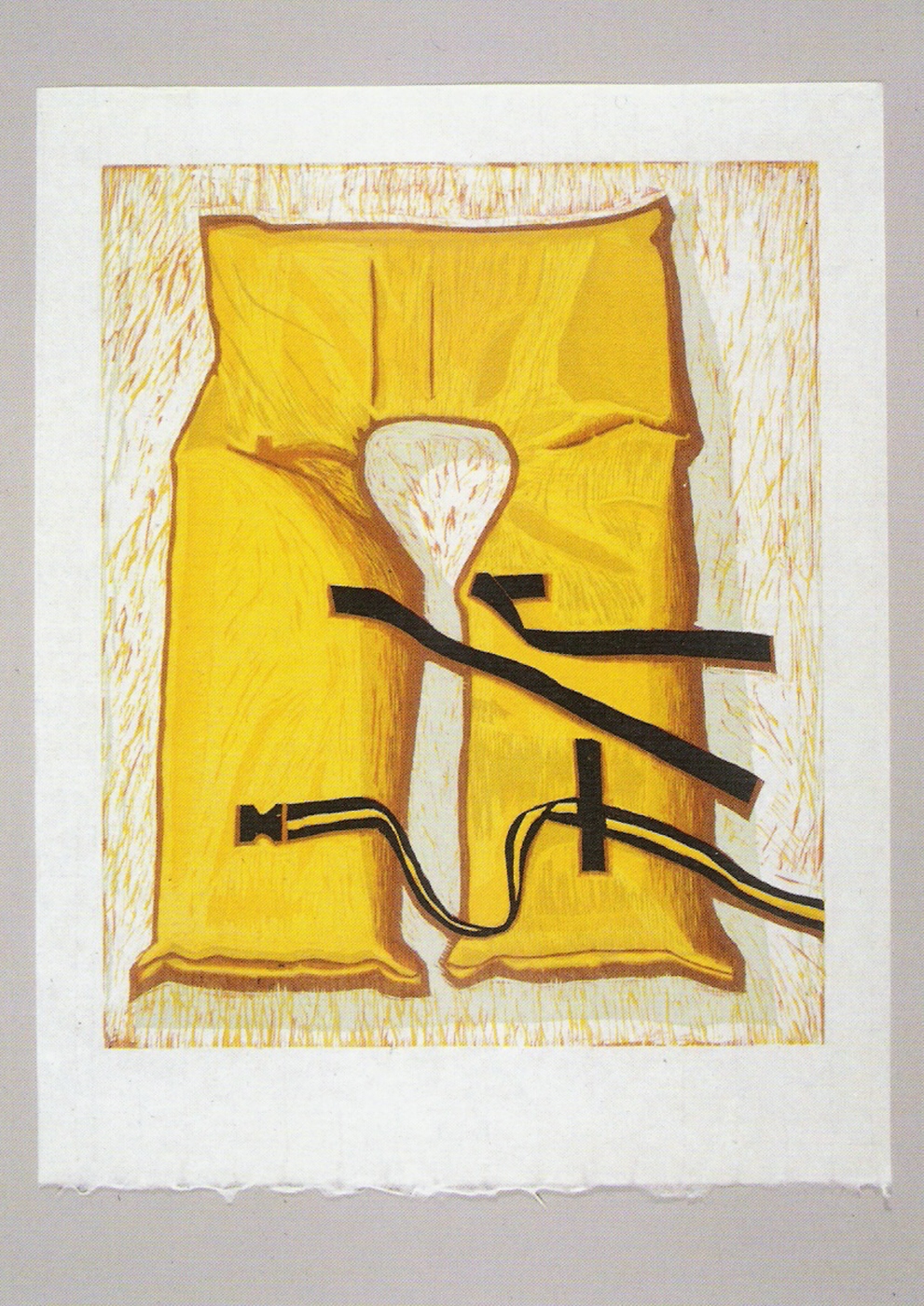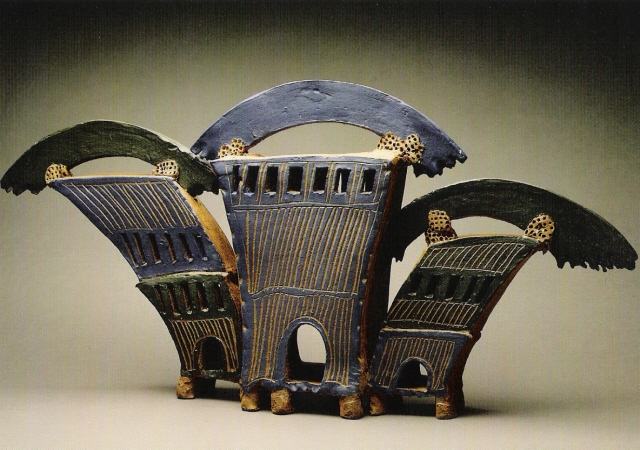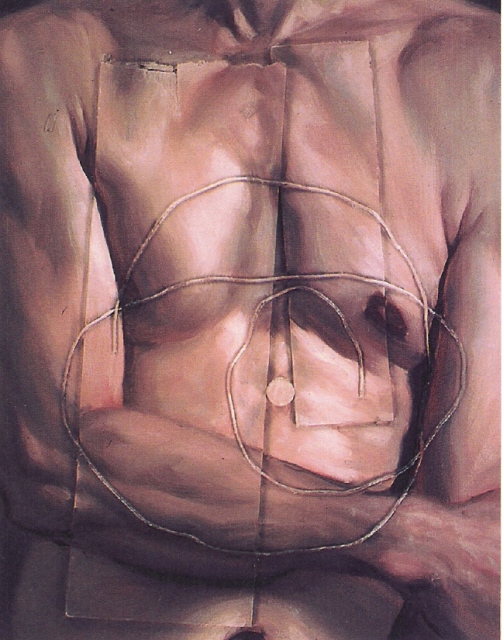Topic: Around Town
Tucked around the Gowanus Canal, nestled into apartments and converted factories and other odd spaces, a surprising number of artists are at work, and once a year they give us the chance to see what they’ve been up to. Yesterday was day one of AGAST, the Annual Gowanus Artists Studio Tour, which I was exploring for my third time, in the company of my friend Daniel. Oh, and just for reference, the tour is FREE. And lots of artists provide munchies besides.
So here’s what we saw, numbered according to the tour map.
Note: If any of this information is wrong, or if any of the artists want their work removed from this site, please contact me and let me know.
 Our first stop, on 3rd Street between Smith and Hoyt, was #22, the apartment/studio of painter Dean Dalfonzo, who was showing mostly nudes and large fruit, along with a smattering of abstracts (he showed us a series of soft colorfield work he’d done for a beachhouse commission), tucked into his basement bedroom, which was also home to a drumset and a pair of guitars, one with an Uncle Tupelo sticker on it. Of his work, I most enjoyed the nudes against the stark background of a plain canvas (pictured).
Our first stop, on 3rd Street between Smith and Hoyt, was #22, the apartment/studio of painter Dean Dalfonzo, who was showing mostly nudes and large fruit, along with a smattering of abstracts (he showed us a series of soft colorfield work he’d done for a beachhouse commission), tucked into his basement bedroom, which was also home to a drumset and a pair of guitars, one with an Uncle Tupelo sticker on it. Of his work, I most enjoyed the nudes against the stark background of a plain canvas (pictured).
 A little further along 3rd was #21, where we saw the work of David Daniel Iliescu and David Lantow. I remembered Lantow as one of the highlights last year, and he didn’t disappoint. His paintings and drawings are intensely sculptural abstract forms, informed by “sea life and animal life,” as well as by the visual style of computer modeling, though the artist doesn’t himself use digital technology for his work. Lantow also mentioned Richard Serra’s Frank Stella’s idea that you should get to know all sides of the image, and Lantow’s oddly compelling forms do feel like you could pluck them from the paper and examine them in three dimensions.
A little further along 3rd was #21, where we saw the work of David Daniel Iliescu and David Lantow. I remembered Lantow as one of the highlights last year, and he didn’t disappoint. His paintings and drawings are intensely sculptural abstract forms, informed by “sea life and animal life,” as well as by the visual style of computer modeling, though the artist doesn’t himself use digital technology for his work. Lantow also mentioned Richard Serra’s Frank Stella’s idea that you should get to know all sides of the image, and Lantow’s oddly compelling forms do feel like you could pluck them from the paper and examine them in three dimensions.
Iliescu’s work, meanwhile, was mostly drypoint on photo paper, which created great glossy works full of strange, complex black and gray shapes and spaces. He was inspired, he said, by music, especially John Cage and his ideas of chance, and wanted to mix intention and chance in his work. One piece he said was based on “some abstract poetry by some Romanian poet.” And then there was his “better use of the TV,” where he had hung a piece of blackened photo paper, with an abstract drawing scratched away, over a flickering television screen, so that the light behind filtered through the design.
As for Gabriel Phipps, who was supposed to be showing on the second floor of the same building, we knocked but got no answer.
 Turning north along the grotty industrial weirdness of Bond Street, we came to #17, the studio of Kingsley Parker,
Turning north along the grotty industrial weirdness of Bond Street, we came to #17, the studio of Kingsley Parker,  an accomplished painter and woodcut artist whose depictions of old maps, big ships and small planes on desert islands evoked the adventure, muscularity and danger of the late age of exploration and the Pacific war in World War II.
an accomplished painter and woodcut artist whose depictions of old maps, big ships and small planes on desert islands evoked the adventure, muscularity and danger of the late age of exploration and the Pacific war in World War II.
Next along the route was #19, where we were welcomed into the three-storey home of painter Joseph Mariano. Just ascending the staircase was an experience. I’m used to seeing Brooklyn’s brownstones chopped into separate apartments, so it was fascinating to see one still used as a family home. The stairway was lined with family photos, the artist’s work, decorative blankets and even framed glass panes painted by the kids or grandkids. The studio, on the third floor, was full of gentle portraits and still lifes.
 The atmosphere of #17 couldn’t have been more different. A thoroughly modern ground-floor space occupied by ten different artists (Paola Borgatta, Colleen Carlson, Leslie Ferretti, Shizue Imai, Yumiko Kuga, Peter Lane, Amanda Moffat, Toshie Otsuka, Pamela Sunday and Joan Walton), New Clay Studios offered a wide range of fascinating ceramic craft and sculpture to enjoy, not to mention the best array of snacks on the tour: apple cider, chocolate, a crate of crisp, tart apples, and rugelach. Rugelach! Of the actual art, I was particularly impressed with Colleen Carlson’s “Strandbuilt” series (pictured), which consisted of everything from dishes and fruit stands to a purse and a pair of buttocks, all constructed from carefully laid strands of ceramic, a technique I’d never seen before.
The atmosphere of #17 couldn’t have been more different. A thoroughly modern ground-floor space occupied by ten different artists (Paola Borgatta, Colleen Carlson, Leslie Ferretti, Shizue Imai, Yumiko Kuga, Peter Lane, Amanda Moffat, Toshie Otsuka, Pamela Sunday and Joan Walton), New Clay Studios offered a wide range of fascinating ceramic craft and sculpture to enjoy, not to mention the best array of snacks on the tour: apple cider, chocolate, a crate of crisp, tart apples, and rugelach. Rugelach! Of the actual art, I was particularly impressed with Colleen Carlson’s “Strandbuilt” series (pictured), which consisted of everything from dishes and fruit stands to a purse and a pair of buttocks, all constructed from carefully laid strands of ceramic, a technique I’d never seen before.
 Next up was #2, over on Baltic Street, where ceramicist Rene Murray greeted us by showing us her beige-brick gas kiln and encouraging us to check out her garden, a lush green enclosure full of dripping hemlocks and junipers. Her most distinctive work was a series of imaginary cityscapes constructed in curious perspective, full of too-steep stairways surprising angles.
Next up was #2, over on Baltic Street, where ceramicist Rene Murray greeted us by showing us her beige-brick gas kiln and encouraging us to check out her garden, a lush green enclosure full of dripping hemlocks and junipers. Her most distinctive work was a series of imaginary cityscapes constructed in curious perspective, full of too-steep stairways surprising angles.
Our furthest point north — what we kept referring to as the “outpost,” where we hoped to be greeted by weary border guards armed with harquebuses to ward off the Mongols — was #1 on the tour, way up between Dean and Bergen on 3rd Avenue, next to the defunct “Andrey’s Caфe.” In an old industrial building, two middle-aged women sat on a sofa across from a terrifying machine of some sort and greeted guests, sending us upstairs to see the work of photographer Robert Redmond, who was showing solidly professional, elegantly composed images of Brooklyn and the region, including a gorgeous shot of the Brooklyn Bridge through a smashed warehouse window; and the abstracts of painter Charles Wilkinson. But alas, no harquebuses.
#4, on Butler St., was another converted industrial space, showing Jeff Leonard’s glassy abstract paintings full of intricate detail, Charles Truett’s big canvases of spattered primary color, and paintings by Jessica Baker based on the erotic sculpture that adorns the temples of Kajuraho, India. She and I had a fun little chat, as travelers to India do, about near-death bus experiences and hallucinatory states achieved through severe diarrhea.
 Next stop was another highlight from previous years, the third-floor studio of painter Sam Clayton (#3), whose large paper and canvas paintings of torsos, often involving complexly textured surfaces, bring to mind the work of Lucian Freud, as well as that of Michelangelo. Clayton is one of the finest artists on the tour, in the sense that he has an extraordinary technical command combined with an enormously powerful visual sensibility. By removing the heads and in most cases hands from his paintings, he strips away the places we look first for meaning. You would think that this might turn the torsos into something abstract, but it has the opposite effect: by forcing us to read them in detail, Clayton gives these muscular torsos a kind of force and intensity and seriousness that is fitting for the part of the body that contains the viscera. But Clayton isn’t a one-note artist: against the monumental quality of the torsos, his smaller landscapes of California — Napa mountains and vinyards, deserts outside of Twenty-nine Palms — have a soft intimacy that expertly capture the laid-back beauty of my home state.
Next stop was another highlight from previous years, the third-floor studio of painter Sam Clayton (#3), whose large paper and canvas paintings of torsos, often involving complexly textured surfaces, bring to mind the work of Lucian Freud, as well as that of Michelangelo. Clayton is one of the finest artists on the tour, in the sense that he has an extraordinary technical command combined with an enormously powerful visual sensibility. By removing the heads and in most cases hands from his paintings, he strips away the places we look first for meaning. You would think that this might turn the torsos into something abstract, but it has the opposite effect: by forcing us to read them in detail, Clayton gives these muscular torsos a kind of force and intensity and seriousness that is fitting for the part of the body that contains the viscera. But Clayton isn’t a one-note artist: against the monumental quality of the torsos, his smaller landscapes of California — Napa mountains and vinyards, deserts outside of Twenty-nine Palms — have a soft intimacy that expertly capture the laid-back beauty of my home state.
 By the time we reached stop #5, it was late in the day, and unfortunately my notes are somewhat confused. There seem to have been considerably more artists than the three listed in the guide. Christopher Doogan’s cartoony woodcuts included an energetic pair of boots that reminded me of Van Gogh’s painting of his shoes, as well as a lovely scene of three old women making dumplings and gossiping. Photographer Dana Matthews offered several compelling series. Among her “Bordello Series,” I was struck by a photograph of a pregnant woman with cropped hair, shown sideways, wearing nothing but a Napoleon-style military tunic and standing before an ottoman. It seemed to combine a whole range of photographic cliches into something new and charged. Tamar Cohen showed a charming series she calls “Babyface,” which are oil paintings of babies, with childish nicknames dancing about the tykes in script etched into the paint. I was especially impressed with the work of Bonnie Steinsnyder, another highlight from last year, whose multipanel paintings and drawings of urban scenes, often divided into sections by strips of found material, skillfully integrate the graphic wit of comics into the non-linear-narrative form of painting, and whose “Goth Club” (pictured) is a marvelous piece of reportage.
By the time we reached stop #5, it was late in the day, and unfortunately my notes are somewhat confused. There seem to have been considerably more artists than the three listed in the guide. Christopher Doogan’s cartoony woodcuts included an energetic pair of boots that reminded me of Van Gogh’s painting of his shoes, as well as a lovely scene of three old women making dumplings and gossiping. Photographer Dana Matthews offered several compelling series. Among her “Bordello Series,” I was struck by a photograph of a pregnant woman with cropped hair, shown sideways, wearing nothing but a Napoleon-style military tunic and standing before an ottoman. It seemed to combine a whole range of photographic cliches into something new and charged. Tamar Cohen showed a charming series she calls “Babyface,” which are oil paintings of babies, with childish nicknames dancing about the tykes in script etched into the paint. I was especially impressed with the work of Bonnie Steinsnyder, another highlight from last year, whose multipanel paintings and drawings of urban scenes, often divided into sections by strips of found material, skillfully integrate the graphic wit of comics into the non-linear-narrative form of painting, and whose “Goth Club” (pictured) is a marvelous piece of reportage.
Just up the block at #6, another industrial building full of studios, we saw the playful clothes and sculptures of Feral Childe, the collaborative team of Alice Wu and Moriah Carlson, complete with pink-fur bench and one of the artists in something very like a clown suit. Another artist with a sense of humor was Doug Anson, whose works on paper parodied the fascinations of middle school boys, full of guns, skulls and rock stars (the bearded “Bass Player” and “Drummer” were a hoot). The haunting paintings of Toto Feldman will stay with me for some time. Young girls, invariably naked and with ram’s horns, seem to be playing out some kind of Narnian drama in the interstices of an imaginary Florida, complete with faceless motels and windblown palm trees. Other galleries at #6 included those of photographer Jeff Amram and painter Rebecca Miller.
 Crossing 3rd Avenue, we came to #7, in the same building as the Spoke the Hub dance studio. Unusual among the participats in AGAST was JCA, an architecture firm. But I was especially struck by the large paintings of Jacob Roesch and Dale Williams. Roesch’s large, naturalistic canvases captured richly complex emotional moments, like the mix of chagrin, resignation and deep thought in the face and posture of a middle-aged man playing croquet (pictured). The energy of Dale Williams’s drawings was completely different: fierce, raw, punk, informed by comics with their exaggerated images and screeds of text. They called to mind Philip Guston’s paintings of a cartoon Nixon with a giant phlebitic leg. I was also taken with the sculptural work of Heather Cox, which included nets made of nail clippers (surprisingly beautiful) and a wedding cake made of aspirins. Other artists at #7 included Jessica Lipsky, Regina McFadden, Richard Egan, Patrick Barrett and Ella Yang. Next door, at #18, we saw the Rubenesque sculptures of Lawrence Berger.
Crossing 3rd Avenue, we came to #7, in the same building as the Spoke the Hub dance studio. Unusual among the participats in AGAST was JCA, an architecture firm. But I was especially struck by the large paintings of Jacob Roesch and Dale Williams. Roesch’s large, naturalistic canvases captured richly complex emotional moments, like the mix of chagrin, resignation and deep thought in the face and posture of a middle-aged man playing croquet (pictured). The energy of Dale Williams’s drawings was completely different: fierce, raw, punk, informed by comics with their exaggerated images and screeds of text. They called to mind Philip Guston’s paintings of a cartoon Nixon with a giant phlebitic leg. I was also taken with the sculptural work of Heather Cox, which included nets made of nail clippers (surprisingly beautiful) and a wedding cake made of aspirins. Other artists at #7 included Jessica Lipsky, Regina McFadden, Richard Egan, Patrick Barrett and Ella Yang. Next door, at #18, we saw the Rubenesque sculptures of Lawrence Berger.
 As the clock ran out on us for day 1, we finished up at the home of photographer Ann Rosen, whose long-haired 15-year-old son answered the door and looked none too happy about it. Rosen has a disarmingly simple approach to portrait photography, taking pictures of families and framing them in written snippets of their life stories for her In the Presence of Family series (pictured), which captures Brooklyn families in all their ethnic complexity. Also on view were her landscapes from Japan, but I was sad to see fewer of her ghostly double-exposure photos of families than in past years.
As the clock ran out on us for day 1, we finished up at the home of photographer Ann Rosen, whose long-haired 15-year-old son answered the door and looked none too happy about it. Rosen has a disarmingly simple approach to portrait photography, taking pictures of families and framing them in written snippets of their life stories for her In the Presence of Family series (pictured), which captures Brooklyn families in all their ethnic complexity. Also on view were her landscapes from Japan, but I was sad to see fewer of her ghostly double-exposure photos of families than in past years.
And that wraps up Day 1, an exhausting but eminently worthwhile journey into the surprisingly rich artistic world of the Gowanus. Stay tuned for Day 2!
Also published on Medium.
